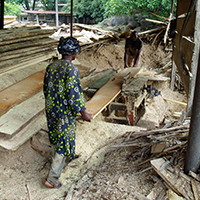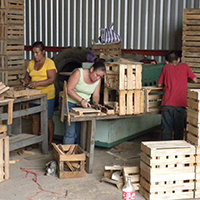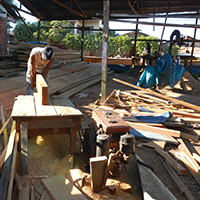Lumber & Panels
This user group supports small and medium-sized producers of tropical lumber, veneer, wood panels, poles and engineered wood products. It will deliver technical and commercial information and collaborate with local entities in their outreach efforts.
Depending on the priorities of local partners, this space could also be used as a “meeting place” to support joint development programs by forest producers and downstream wood manufacturers. For example, a joint program could develop log grades and lumber grades tailored for furniture manufacturers or lumber grades for structural wood construction.
ITTO seeks expressions of interest from local producer organizations and senior technical specialists to participate in the editorial panel for this user group. Please contact: Ramon Carrillo, carrillo@itto.int




Last updated 12/2/2015
REFERENCE SECTION
A
- ABC of WEBSITE - Replacement Search Guide - 1. Ability to do Searches to Replace globally traded temperate forest timber species will be added in due course (see list in "temperate species"). 2. Tropical timber species are selected for further analysis as replacement candidates, using the following comparison criteria: Must be within + or - 20% of Air Dry Density ("Weight") AND Side hardness Janka, AND Moisture Movement (Total Tangential Shrinkage %) of the species. being replaced AND, Must be within one rank (+ or - ) for both Index of Natural Durability and Index of Color (both are only approximate measures).
- ALL KILN DRYING PROGRAMS - For British programs click: KD_British, For Grupo Andino programs click: KD_JUNAC, For USA programs click: KD_USA, For Japanese programs click: KD_Japan, For French programs click: KD_French, For Brazilian programs click: KD_Brazilian1, For Fiji programs (includes coconut palm) click: KD_Fiji
- ABC - Moisture Movement (Tangential Shrinkage,Total) - "Moisture movement¨ is the popular term used to describe the dimensional change response of a given species for a given change in its moisture content. In this website it is represented by Total Tangential Shrinkage, defined as the dimensional change of the tangential face of a piece of wood when it dries from the green or ¨saturated¨ condition (27-30% Moisture Content) to the oven-dry condition (0% MC) . It is expressed as a % of the green dimension. Used in this website as one of the criteria for selecting replacement species. (Not to be confused with Normal shrinkage which is the linearly prorated, smaller shrinkage, measured from the saturated state to the air dry condition of 12% MC.) Total Tangential shrinkage of 7-11% is Medium Total Tangential shrinkage greater than 11% is Large. Total Tangential shrinkage smaller than 7% is considered Small.
B
- BIOFUELS - Wood and Bark as Fuel - "Wood and Bark as Fuel" Corder S.E. 1973 FRL-OSU. Access the full report of this classical 28 pp. publication in English. Courtesy of Oregon State University, Corvallis, USA.
http://www.tropicaltimber.info/wp-content/uploads/2015/06/Wood-and-Bark-as-FuelCorder-S.E.1973-RB_no_14-Forest-Research-Laboratory-Oregon-State-Univ-Corvallis-Oregon-28-pp..pdf
Download the PDF (3 MB)
D
- DRYING - Drykiln Operators Manual USDA FPL - The USDA FPL AH-188 is a classical publication in English edited in 1991 by W. Simpson. Covers wood physics of water movement, kiln design and operation, process controls, moisture content tracking, lumber sizes and allowances, schedule types, energy consumption, among many other topics. Offered by permission and courtesy of the USDA Forest Products Laboratory, Madison, WI, USA.
http://www.tropicaltimber.info/wp-content/uploads/2015/09/USDA.FPL_.AH188.Rev1991DryKilnOperatorsManual.pdf
Download PDF (18 MB) - DENSITY - Wood Density Variation-Juvenile Wood - Many tree species have lower density, maybe juvenile wood, in the center part of log and decreasing density along the height of the stem.
Well illustrated by applied research in South Africa plantations by Oxford University.
Download PDF
http://www.bodley.ox.ac.uk/users/millsr/isbes/ODLF/TFP43.pdf - DRYING - Lumber Drying Schedules, USDA -
The complete list of dry kiln schedules developed or tested by USDA Forest Products Laboratory is included in the classic 1988 publication in English by S. Boone et al. Includes species from Americas, Asia and Africa. Bibliography items separated by regions Nrs 13, 22, 317.
http://www.tropicaltimber.info/wp-content/uploads/2015/09/USDA.FPL_.AH188.Rev1991DryKilnOperatorsManual.pdf
Download USDA FPL Publication GTR 57 by S.Boone (746 Kb). - DRYING - Lumber Drying Schedules - USDA FPL Dry Kiln Schedules for worldwide Woods.
Download the PDF - DRYING - Lumber Drying Groups - Provides criteria for grouping species for drying.
http://www.fpl.fs.fed.us/documnts/fplrn/fplrn263.pdf - DRYING - Lumber - An excellent short description of kiln drying is in the Iowa State Univ. Forestry Extension Note F-328, 1999. Internet link. For a detailed explanation see "wood properties".
http://www.extension.iastate.edu/forestry/publications/pdf_files/f-328.pdf - DRYING - ITTO Wood Drying - Visit the main ITTO site to learn more.
http://www.itto.int/project_search/?proid=&keyword=wood+drying&submit=&donor=&status=COMPLETED&areasofwork=&prolevel2= - DRYING - Green Wood - Wood before drying, directly after harvesting. It also refers to freshly cut woods which have not undergone any treatment. The moisture content in green wood varies with the species and the season.
- DRYING - Weight Stacks of Wood - To reduce warping, weighting on a stack of wood, between drying or stacking time.
- DRYING - Moisture Content - The weight of water expressed as a percentage of the oven-dry weight.
- DRYING - Fiber Saturation Point (FSP) - The point at which there is no more free water in cell cavity, but the cell walls are still saturated with absorbed water. Approximately occurs at Moisture Content = 28% but varies with species.
- DRYING - Sap Stain Defects - Staining in sapwood due to fungi attack.
- DRYING - Water Pocket Defects - Spots of high moisture content remaining in a dried piece of wood.
- DRYING - Mild Kiln Schedule - Softly/mild accelerated schedule, to prevent a risk of defect occurrence, need long time.
- DRYING - Severe Kiln Schedule - Severe time acceleratedschedule, high risk of defect occurrence, need short time.
- DRYING - JUNAC Kiln Schedule - Schedules proposed for South American wood species by the JUNAC (Andean Pact).
http://www.fpl.fs.fed.us/documnts/fplrn/fplrn263.pdf - DRYING - U.K. Kiln Schedule - Schedules from the Handbook of Hardwoods (United Kingdom)
Download the UK Kiln Schedule - DRYING - U.S. Kiln Schedule - Schedules from the book Tropical Timbers of the World (Forest Service, United States of America). For more information please download the PDF below.
Download the PDF - DRYING - Japan Kiln Schedule - Schedules from Forest Experiment Station in Japan.
Download the Japan Kiln Schedule - DRYING - French Kiln Schedules - These are only the lumber dry kiln schedules from French sources which were recomended by the original ITTO Database of 2002. A wider and updated set of schedules are available from Tropix by CIRAD in France.
- DRYING - Kiln Schedule - Processing schedule in a dry kiln. Steps of increasing severity in temperature, relative humidity, ventilation cycles and air circulation are applied for a certain timber species and thickness as the load of wood loses its moisture. Step changes of dry bulb (DB) temperature and relative humidity (RH) can be performed manually, at set time intervals or automatically, according to feedback measurements of moisture content in wood samples.
- DRYING - O.D. - Oven-Dry
- DRYING - Madera Anhidra - Muestra de madera secada en horno ventilado a 101 a 105 °C (215 to 220 °F) hasta llegar a peso constante ó anhidro (ASTM 4442-07). Oven-dry, en inglés.
- DRYING - MC 12% - Moisture content of 12% in realtion to the oven-dry basis.
- DRYING - Recondition - Midway or at the end of kiln drying, a steaming-technique used to equalize drying conditions throughout a load of wood.
- DENSITY - Tree Density Variation - Many tree species have lower density in the center part of log, maybe juvenile wood, and density variation along the height of the stem.
http://www.bodley.ox.ac.uk/users/millsr/isbes/ODLF/TFP43.pdf - DRYING - Volumetric Shrinkage - It is the total dimensional variation of wood from green condition to oven-dry condition. It is measured on wood or estimated as an addition of the radial and tangential shrinkage (expressed as % of green dimension).
- DRYING - Radial Shrinkage - It is the dimensional variation in the radial direction of wood from green condition to oven dry condition (expresed as a % of the green dimension).
- DRYING - Equilibrium Moisture Content - Is the moisture content (MC%) which wood from a certain species will tend to equalize at over time for given combination of air temperature and air relative humidity.
- DRYING - Kiln Drying - Drying process to reduce the moisture content of wood by using a kiln in which all drying parameters can be controlled.
- DRYING - Artificial Drying - Drying process in which drying factors such as temperature, relative humidity and air velocity, are under control.
- DRYING - Seasoning - Drying of lumber and logs , taking place in an open air condition or a shed but not in a kiln.
- DRYING - Air-drying - Drying in open air sheds where drying factors such as temperature, relative humidity and air velocity cannot be controlled. Depending on the local climate, species, size and stacking, final moisture contents of 8-15% can be attained after several weeks or months.
- DRYING - Normal Shrinkage - Dimension loss from saturated or "green" condition to 12% MC as a % of the green dimension.
- DRYING - Total Shrinkage - Dimension loss from saturated or "green" condition to 0% MC (oven-dry condition) as a % of the green dimension.
- DENSITY - Definition Wood Density - Density is accepted as a valid and reasonable basis for estimating the suitability of timber species for various uses. The density measured for a given piece of wood can vary significantly depending of the moisture content it had when the the weight was measured and when the volume was measured. For professional use, both of these moisture contents must always be explicitly stated together with the wood density value.
- DENSITY - Basic Density, Basic Specific Gravity of Wood - Density based on the oven dry weight and the saturated or "green" volume. A theoretical construct, it is the lowest possible density value for a given species and the most accurate basis of comparison between species. Practical for estimating MC% of air seasoned wood samples above or close to the fiber saturation point (27-30% MC) by weighing. Sometimes called "basic specific gravity of wood".
- DENSITY - Green - Density based on both the weight and the volume measured in the saturated or "green" condition.
- DENSITY - Oven-dry density Definition - Density as the ratio of the oven-dry weight over the oven-dry volume.
- DRYING - Contracción Total - Contracción Total es la pérdida de dimensión desde estado saturado o " verde" hasta CH12%, como % de la dimensión verde.
- DRYING - CH 12% - Contenido de Humedad de 12% (Como % del peso anhidro)
- DRYING - Contenido de Humedad de Equilibrio - Contenido de humedad (CH%) al cual tiende la madera de una especie determinada para una combinación dada de temperatura y de humedad relativa del aire ambiente.
- DRYING - Defects - Collapse - Cell wall collapse occurring in some species when drying above fiber saturation point. In some species, collapse results in severe deformation of the affected piece of wood.
- DRYING - Wet and Dry Bulb Thermometer - A set of two thermometers used in dry kilns. The bulb of the wet bulb thermometer is wrapped in a wet wicker and indicates a lower temperature than the dry bulb thermometer when its water evaporates faster. A larger drop in the temperature of the wet bulb thermometer indicates a lower relative humidity of the circulating air. The Differential of temperatures between dry bulb and wet bulb (depression), is sometimes used in dry kiln schedules to represent the relative humidity of the air.
- DRYING - Twist - A kind of warp after drying.
- DRYING - Crook - A kind of warp after drying.
- DRYING - Bow - A kind of warp after drying.
- DRYING - Defects - Cup - A kind of deformation after drying; most common with wider boards which are flat sawn.
- DRYING - Honeycomb - A kind of defect at drying consisting of internal checks or voids.
- DRYING - Manual de Secado de Maderas, Grupo Andino - "Manual de Secado de Maderas", Grupo Andino
Bajar Documento - DRYING - Oven-Dry Condition Procedure - Wood sample dried in a ventilated oven at 101 to 105 °C (215 to 220 °F) for 48 hrs or until constant weight reached at 0% M.C. (ASTM 4442-07) . Learn more about the practical aspects of oven-drying wood samples as applied to biomass, in the PDF below.
Download PDF
http://dnr.wi.gov/topic/ForestBusinesses/documents/BiomassMoistureContent.pdf
Download PDF
G
- GRADES and SIZES - Plywood Grades -
http://www.apawood.org/resource-library - GRADES and SIZES - Lumber Grades -
http://www.ahec.org/hardwoods/pdfs/IllustratedGradingGuide.pdf - GRADES and SIZES - Clasificación Tableros Madera Estructural -
- GRADES and SIZES - Clasificación Madera Estructural -
- GENERAL - Included Phloem - Inserted bark inside the woody tissue of stem.
- GENERAL - Radial Face, Quarter-Sawn Lumber, Vertical grain - When the face of a board intersects annual gowth rings at 90 deg. angle. The shrinkage rate of radial faces is substantially lower than for tangential faces. ¨Quarter sawn lumber¨ or " vertical grain" lumber (as opposed to "flat sawn" lumber) is often sought after for millwork, joinery, stair steps and for species like eucalyptus or oak that are prone to drying defects.
- GENERAL - Tangential - Face of board is tangential to annual gowth rings. "Flat-sawn lumber"
- GENERAL - Cara Radial - Cara radial de la madera es perpendicular a los anillos de crecimiento anual. Madera muestra veta "cuarteada" o lineas paralelas en sentido longitudinal de la fibra, mas visibles en especies no tropicales.
- GENERAL - Cara Tangencial - Cara de la pieza de madera es tangencial a los anillos de crecimiento. Madera con veta "floreada" presenta ojivas en sentido longitudinal de la fibra, mas visibles en especies no tropicales.
- GENERAL - Interlocked Grain - A wood grain in which the fibers incline in one direction in a number of annual rings and in a reverse direction in succeeding rings. Causing a distortion in sawn-board. In Japanese market a log which has a interlocked grain is sawn in quarter boards (radial plane boards).
I
- INDUSTRIALIZATION - Tensionado Sierras -
http://www.chapingo.mx/dicifo/publicaciones/mantenimiento_sierras_cintas_y_circulares_2008.pdf - INDUSTRIALIZATION - Sawdoctoring -
http://www.fao.org/docrep/016/s8870e/s8870e00.pdf - INDUSTRIALIZATION - ITTO Projects Small Sawmills - Get information from the ITTO main site on completed ITTO projects about Small and Portable Sawmills.
Get
http://www.itto.int/project_search/?proid=&keyword=portable+sawmills&submit=&donor=&status=COMPLETED&areasofwork=&prolevel2= - INDUSTRIALIZATION - ITTO Plywood Manufacturing - Visit the main ITTO site to learn more.
http://www.itto.int/project_search/?proid=&keyword=plywood+manufacturing&submit=&donor=&status=COMPLETED&areasofwork=&prolevel2= - INDUSTRIALIZATION - ITTO Industry Development - Visit the ITTO main site to learn more.
http://www.itto.int/project_search/?proid=&keyword=industry+development&submit=&donor=&status=COMPLETED&areasofwork=&prolevel2= - INDUSTRIALIZATION - Afilado Calibracion Sierras -
http://www.mincetur.gob.pe/comercio/OTROS/penx/estudios/Afilado/MANUAL1.pdf - INDUSTRIALIZATION - Chipped Grain, Pick-up Grain, Torn Grain Defects - The release of wood chip or fiber bundle generally during and due to sawing and planning, giving the surface a more or less wooly appearance.
- INDUSTRIALIZATION - Wooly Surface - The release of fiber, generally during sawing, giving the surface a more or less wooly appearance.
- INDUSTRIALIZATION - Fuzzy Grain - The release of fiber, generally during sawing, giving the surface a more or less wooly appearance.
- INDUSTRIALIZATION - Plywood - Veneer - Face veneer for plywood. Outer-most surface veneer of plywood needs a high grade veneer, sometimes decorative veneer produce by a slicer rather than rotary cutting, also called "peeling".
- INDUSTRIALIZATION - Defects - Blunting Effect - Defects due to the blade of equipment becoming dull (blunted) by silica and so on. The Kife-edge was observed by S.E.M. until 500 m total cutting use. Shorea spp.(Merapi).
- INDUSTRIALIZATION - Plywood - Cores - Core veneer for plywood. Inner layer of multilayers of plywood does not need high grade veneer. Usually produced by rotary cutting, also called "peeling".
- INDUSTRIALIZATION - Silver Grain - An attractive figure formed by the conspicuous rays in quarter-sawn wood, which is much paler than the rest of the wood.
- IDENTIFICATION - Stone Cells - A sclereid that has become hardened by secondary deposits as in pear.
- IDENTIFICATION - Tropical Timbers of the World, USDA-FPL - "Tropical Timbers of the World", Chudnoff, M. 1984, USDA-FPL Handbook 607.
Download the PDF - INDUSTRIALIZATION - Mantenimiento Sierras - "Manual de Mantenimiento de Sierras Cintas y Circulares", Chapingo, México. 2008
http://www.chapingo.mx/dicifo/publicaciones/mantenimiento_sierras_cintas_y_circulares_2008.pdf - INDUSTRIALIZATION - Adhesives with Wood - Learn more in the in "Chapter 10.Wood Handbook, USDA-FPL, GTR-190" or download the Wood Handbook, Wood as an Engineering Material in the PDF link.
Download the PDF
M
- MARKETING - ITTO Projects Product Development - Get information off the ITTO main website about completed ITTO projects on Product Development.
Get
http://www.itto.int/project_search/?proid=&keyword=product+development&submit=&donor=&status=COMPLETED&areasofwork=&prolevel2= - MARKETING - ITTO Market Studies - Visit the ITTO main site to learn more.
http://www.itto.int/project_search/?proid=&keyword=market+studies&submit=&donor=&status=COMPLETED&areasofwork=&prolevel2=
P
- PROTECTION OF WOOD - Wood Preservation -
http://www.awpa.com/references/specifier.asp - PROTECTION OF WOOD - ITTO Wood Preservation - Visit the main ITTO site to learn more.
http://www.itto.int/project_search/?proid=&keyword=wood+preservation&submit=&donor=&status=COMPLETED&areasofwork=&prolevel2=
R
- RETAIL BUYERS - Product Standards -
Download the PDF
W
- WORKABILITY - Bending - Technique to make a curved wood part in chair, tennis rackets and so on, mainly after steaming or cooking a wood. Softened wood is bent using a model frame or "jig".
